MARTIAL ARTS IN CHINA
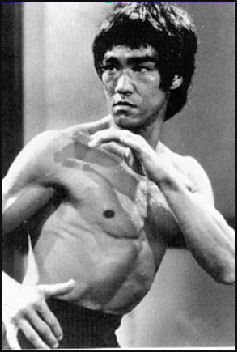
Bruce Lee, the man who
popularized Chinese martial arts The martial arts in China are sometimes divided into the "hard school" martial arts and the "soft school" martial arts. Among the "hard school" martial arts are “hung kuen” ("red fist"), adapted by the Japanese to become karate, and “hau kuen” ("monkey fist"), associated with a Tang dynasty legend about the Goddess of Mercy ordering the monkey god to accompany the Buddhist monk, Tong Sam Chong, to Tibet to collect Buddhist scriptures. "Soft school" martial arts include “paat kaw” and “luk hop paat faat”.
One of the basic premises of all martial arts to use the strength of an opponent against them rather than relying on your own individual strength. The form of martial arts practiced by Bruce Lee is “jeet kune do”.
Many Chinese martial arts forms use weapons such as swords and staffs and seem to have more in common with dance and acrobatics than sword fighting or fencing, or for that matter boxing or wrestling. A.C. Scott wrote in “The International Encyclopedia of Dance”, “Dancing with weapons has always been an admired art in China....There are dozens of styles demanding skill with long swords, scimitars, or spears, which originated in ancient calisthenic exercises. There are two broad categories of movements: one stresses relaxation and flexibility, providing the means to counter violence through resilience; the second style emphasizes speed and strength. Both utilize weapons play and have their own variations of crouching, twists, turns and leaps.”
”Chun Yi: The Legend of Kung Fu” is a musical theater production featuring twirling, spinning Shaolin-trained martial artists in grease paint and costumes. The show has been running at the Red Theater in Beijing since 2004 and has toured Canada, Russia, Britain and Japan.
See Separate Articles: SHAOILIN TEMPLE, ITS FIGHTING MONKS AND SACRED MOUNT SONG factsanddetails.com ; SPORTS IN CHINA factsanddetails.com KUNG FU IN CHINA, SHAOLIN TEMPLE AND BRUCE-LEE-STYLE KUNG FU factsanddetails.com JIN YONG AND WUXIA (CHINESE MARTIAL ARTS FICTION) factsanddetails.com ; MARTIAL ARTS FILMS: WUXIA, RUN RUN SHAW AND KUNG FU MOVIES factsanddetails.com ; BRUCE LEE: factsanddetails.com ; JACKIE CHAN factsanddetails.com ; JET LI factsanddetails.com
See Film, Literature
Good Websites and Sources: Wikipedia article on Chinese Martial Arts Wikipedia ; Shaolin Gunf Fu Institute shaolin.com Travel China Guide ; Travel China Guide ; Introduction to Chinese Martial Arts nardis.com ; Wikipedia on Shaolin Temple Wikipedia ; Shaolin Chan City shaolinchancity.blogspot.com : Tai Chi Tai Chi Quan wfdesign.com ; Tai Ch and Qi Qong literati-tradition.com ; Wikipedia articles on Tai Chi Wikipedia
Good Websites and Sources on Sports in China: Wikipedia article Wikipedia ; China Sports Today chinasportstoday.com ; China Daily Sports chinadaily.com.cn ; China Sports Review chinasportsreview.com ; China Sports Blog chinasports.wokpopcorn.com ; South China Morning Post Sports scmp.com ; Sports in Ancient China Chinese Olympic Committee ; Traditional Sports Travel China Guide
Links in this Website: SPORTS, RECREATION, PETS on the Main China Page factsanddetails.com/china (Click Sports, Recreation, Pets); SPORT IN CHINA Factsanddetails.com/China ; TABLE TENNIS IN CHINA Factsanddetails.com/China ; MARTIAL ARTS IN CHINA Factsanddetails.com/China ; CRICKET FIGHTING AND UNUSUAL SPORTS IN CHINA Factsanddetails.com/China ; RECREATION IN CHINA Factsanddetails.com/China ; ENTERTAINMENT IN CHINA Factsanddetails.com/China ; GAMES AND GAMBLING IN CHINA Factsanddetails.com/China
Wushu
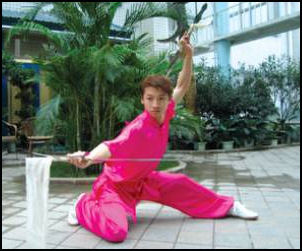
Wushu is a modern, dance-like acrobatic form of kung fu. The martial arts featured in teh film “Crouching Tiger, Hidden Dragon” are regarded as forms of wushu. Wushu will debut as an Olympic sport in the 2008 Olympic in Beijing but no medals will be awarded.
Wushu as an organized sport has been around for some time. In the Han era the rules of wushu were written down in manuals used to train military conscripts. The first Chinese Olympic team’sent to the 1936 Olympics in Berlin — included a wushu team that performed before Hitler. Seven-year-old Jet Li was a member of a junior wushu team that performed on the White House lawn in front of Richard Nixon and Henry Kissinger in 1974.
Unlike kung fu which aims to remain close to its traditional forms, wushu is constantly evolving, and adding new stunts and movements. Advanced moves include running up a wall and flipping backwards, spinning 720 degrees while doing a tornado kick, and performing a twisting butterfly kick, which looks like something performed by an Olympic diver.
Basic wushu emphasizes doing movements and kicks with a straight back and extended arms or from a crouching position, like Jet Li often does, with the right arm and the palm held up. There are basic straight leg kicks, such as the front and side stretching kick and the outside and inside crescent kick. Gifted students began leaning how to do butterfly kicks after around six months or so of training.
Wu means “military — and indicates skill with combat forms and weapons. In the old days it was a form of military training and a kind of calisthenics. Some forms were designed for physical exercise while others helped train men for hand-to-hand combat or fighting with weapons.
Chinese Martial Arts and the Olympics
There is widespread resentment that kung fu, wushu and other Chinese forms or martial arts have not been accepted as Olympic sports. Theories as to why include the fact the Olympics already has too many sports, the late candidacy of the sports, doubts as to whether Chinese martial arts are real sports and biases in the West against Asian martial arts as sports.
A kung fu tournament was held during the Olympics but it was not part of the Olympics and the tournament itself was diminished by the fact that monks from Shaolin temple did not take part Explaining why his monks didn’t show up the abbot of Shaolin said, “In competition you must have rules about what you can and can not do — you don’t just fight. But the monks at Shaolin do not fight for show — we fight to defeat our opponent, by any means necessary.”
Rival schools felt that Shaolin didn’t compete because it was afraid of losing and comprising its reputation. Liu Haiqin of the Tagou School said, “If you ask me, “are they scared?” I couldn’t deny there’s something in that...How many champions have they trained? How many medals have they won? The best place in the world for kung fu is our school.” In response the abbot of Shaolin said, “We could beat those people.”
The actor Jackie Chan has said he would like wushu to be made an Olympic sport. The International Olympic Committee recognizes wushu as a sport but has not made it an official Olympics sport as it has with other Asian martial arts such as tae kwon do from Korea and judo from Japan.

Tai chi in Riotan Park in Beijing
Tai Chi in China
Tai chi (known as taijiquan or tai chi chuan in China) means "slow motion shadow dancing" or "supreme ultimate fist." Practiced for more than 2,500 years, it is a form of exercise and calisthenics that incorporates elements of the martial arts, dance and Eastern mysticism. Tai chi is an effortless and rhythmic art that stresses slow breathing, balanced and relaxed postures and absolute calmness of mind. It requires no equipment and no special place to practice and is associated with northern China.
In the early morning, when positive ions are said to at their highest concentrations, many old Chinese can be seen in parks in the cities performing tai chi. Young women often do tai chi to keep slim and fit and large groups sometimes do it in unison to a disco beat. Tai chi is also promoted as way to improve breathing, digestion and muscle tone. Some people do two hours of tai chi every day.
Tai Chi, Taoism and History
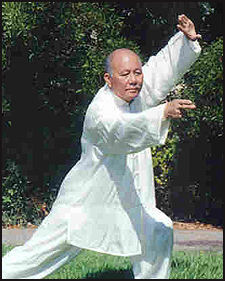
Although tai chi is secular its spiritual underpinnings are deeply Taoist. The gentle, slow movements and abdominal breathing all come from Taoist health and longevity exercises. The slow movements are believed to stimulate the flow of qi ("vital energy"), control the balance of yin and yang and produce harmony with the universe.
The origins of tai chi are unclear. It wasn't widely practiced by the Chinese public until the mid-19th century when the master Yang Lu Chan taught the martial art to the Manchu Imperial Guard and later to mandarin scholars.
Tai chi was promoted by the Communists as a means of improving the health of ordinary Chinese. In efforts to reduce the likelihood of "comrades fighting comrades" the combative aspects of the activity were downplayed. Tai chi was very popular among old people in the 1970s and early 1980s. It is still popular but has since lost participants to ballroom dancing, yang ge dance, Falun Gong and other practices.
Tai Chi Movements
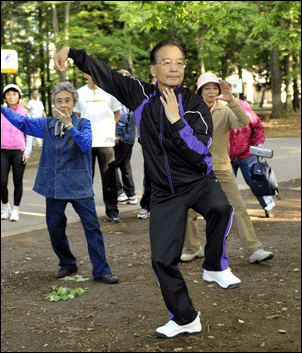
Chinese Premier Wen Jiabao
doing tai chi
Practitioners of tai chi concentrate on maintaining perfect balance while flexing their muscles and shifting from one stylized position to another. The movements are fluid and circular and are often inspired by animals such as cranes, praying mantises and monkeys.
Describing an elderly Chinese man practicing tai chi, Andrew Salmon wrote in the Korean Times: He "is moving through a series of slow, graceful movements. At one point his posture — with arms outstretched and balanced on in leg — resembles a crane spreading its wings, at another — in a low stance close to the ground — he appears to be snake winding its way along a branch."
There are two main tai chi forms: 1) the Yang style, featuring extended, graceful movements. 2) the Chen style, featuring coiling, spiraling and sudden explosive stomps, kicks and punches and sometimes showcases the traditional tai chi weapons, the straight sword and saber.
A study published in April 2011 in the Boston-based Archives of Internal Medicine found that tai chi helps patients with chronic heart disease. In the study 50 U.S. heart patients who took tai chi classes and 50 patients who took classes in heart education were compared. The tai chi group gave “significant” number of positive answers in a questionnaire to access their emotional state and showed more confidence in performing certain exercise-related activities. Gloria Yeh of Beth Israel Deaconess Medical Center said that while scientists to not understand the science behind the finding, “Tai chi appears to be a safe alternative to low-to-moderate intensity conventional exercise training.Tai chi is safe and has a good rate of adherence and may provide value in improving daily exercise, quality of life, self-efficiency and mood in frail” patients.
Wrestling and Boxing in China
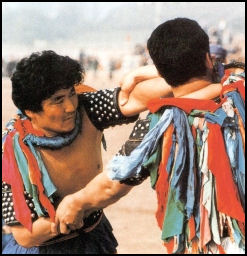
Traditional wrestling
Imperial wrestlers traditionally raised pigeons and hunted badgers with falcons in graveyards in their free time. They remained in Beijing after the fall of the Qing dynasty in 1919.
Professional boxing was banned as a “dangerous sport” in the 1950s after a fighter died in the ring. In 2004, the China government considered dropping the ban.
Olympics-style boxing has been allowed since 1986, when boxers earned an average of $25 a month. China has a handful of boxing clubs. At the now closed Bison Boxing Club in Beijing fights often broke out between gamblers during the fights and 30 or so beefy bouncers, wearing motorcycle helmets, were hired to keep order.
China’s first professional boxing title was claimed by a woman. In April 2006, Zhang Xiyan outpointed American Alicia Ashley to win the World Boxing Council’s women lightweight crown.
Mike Tyson is popular in China. One reason why is that he has a picture of Mao tattooed on his arm. The Shanghai suburb of Luodian offered Tyson an honorary citizenship then withdrew the offer after more carefully considering his scandal-plagued career.
Sumo wrestling was brought to China from Japan in exhibition form in 2005.
In May 2009, Xiong Zhaizhing became the first male Chinese boxer to contend for a world title when he faced off against WBC champion Daisuke Naito of Japan in a flyweight division fight. Although Xiong knocked down Naito in the sixth round Naito prevailed and won the figh.
Boxing at the 2008 Beijing Olympics
China won four boxing medals in Beijing, including two golds, after just managing one medal in previous Olympics. It had poured a lot money and resources into boxing. With 11 weight divisions, it was one of those sports that China decided to focus on as it provided many opportunities to win medals. The bouts were fought in the Worker’s Gym, a large, circular, half-century old building that provided a good atmosphere for boxing.
Zhang Xiaping of China won the Olympic light-heavyweight title in a controversial win over Ireland’s Kenny Egan. Zhang was the beneficiary of a controversial semifinal victory over Yerkebulam Shynaliyev. Zhang won 11-7 over Egan with the of help points scored from punches that looked as of they didn’t land cleanly.
Zhang Zhilei won the silver medal in the super heavyweight division, after getting pummeled by Italy’s Roberto Cammarelle in the gold medal match. His was the 100th medal and last medal that China won at the Olympics. Chinese Muslim Hanati Silamu, an ethnic Kazakh from Xinjiang, won a silver medal in the welterweight division.
Many felt the judges favored Chinese boxers. One Chinese boxer rallied to overcome a three point deficit in the final seconds scoring points when he seemed to be in the grasp of his opponent. Another won despite head butting his opponent three times.
Zou Shiming
Zou Shiming won China’s first gold medal boxing, in the light-flyweight division, without hardly throwing any punches, defeating Serdamba Purvedorj of Mongolian in the final after Purvedorj retired in the second round with a shoulder injury. Zou clinched a medal with a 15-0 victory over Paddy Barnes of Ireland. After winning the gold, Zou said the final bout “made it look like I easily won the gold medal, but there was much work and preparation that went into this. It’s regrettable that I couldn’t be more entertaining to my fans in the gold medal bout, but most important is to get the gold medal, which I did.”
Zou was regarded as China’s best hope for a gold medal in boxing. A light flyweight, he won China’s first boxing medal, a bronze, in 2004 in Athens. After that he won two world championships. Don King showed up to watch one of his bouts. Some predicated he world turn out to be one of the big stars of the Olympics.
Zhou is known for his quick, accurate jabs. He wore golden boots and blew kisses to the crowd before his bouts. Only 5 foot 5 and 106 pounds, he grew up watching martial arts films and practicing wushu but somewhere along the way picked up moves that were classic Mohammed Ali. In his bout against the Barnes he played to audience, winning cheers every time he did a little shuffle while dancing around the Irishman. He was initially picked over for boxing by recruiters because his armed were deemed too short.
Image Sources: 1) Wikipedia; 2, 4) 3) Nolls China website http://www.paulnoll.com/China/index.html ; 5) Wushu Academy; 6) China Hiking com; 7) Fitness Resources; 8) CNTO Jiabao picture, China.org
Text Sources: New York Times, Washington Post, Los Angeles Times, Times of London, National Geographic, The New Yorker, Time, Newsweek, Reuters, AP, Lonely Planet Guides, Compton’s Encyclopedia and various books and other publications.
Last updated July 2011
